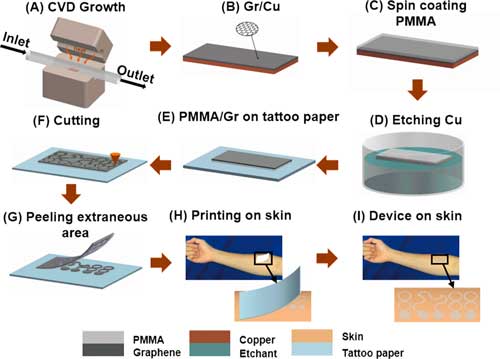| Posted: Jul 31, 2017 | |
Graphene-based tattoo-like skin biosensors |
|
| (Nanowerk Spotlight) Graphene is the thinnest electrically conductive material, optically transparent, mechanically robust, electrochemically stable, and biocompatible – ideal prerequisites for fabricating epidermal electronics or tattoo-type biosensors. | |
| In previous Nanowerk Spotlights and articles we have reported on various sensor devices that researchers have developed to fabricate a graphene nanosensor tattoo on teeth to monitor bacteria; graphene electrodes for simultaneous electrophysiology and neuroimaging; transparent graphene neural electrode arrays for electrophysiology, in vivo imaging, and optogenetics; and wearable graphene-based biomedical device to monitor, combat diabetes. | |
| In these and similar applications, the total thicknesses of the graphene-based sensors are tens or hundreds of micrometers, which is too large to fully conform to the skin like a real tattoo and act as electronic skin. Moreover, while the aforementioned graphene biosensors were successfully patterned by photolithography, the process can be costly and time-consuming. | |
| In new work, led by professors Deji Akinwande and Nanshu Lu, researchers have developed a stretchable and transparent graphene-based electronic tattoo (GET) sensor that is only hundreds of nanometers thick but demonstrates high electrical and mechanical performance. | |
| The team reported their findings in ACS Nano ("Graphene Electronic Tattoo Sensors"). | |
 |
|
| Fabrication process of GET. (A, B) Graphene was grown on copper foil using atmospheric pressure chemical vapor deposition system (APCVD). (C) Less than 500 nm thick PMMA was spin coated on graphene. (D) Copper was etched away. (E) Graphene/PMMA (Gr/PMMA) was transferred onto tattoo paper with PMMA touching the paper and graphene facing up. (F) Gr/PMMA was cut by a mechanical cutter plotter. (G) Extraneous Gr/PMMA was peeled off from the tattoo paper. (H) Mounting GET on skin like a temporary transfer tattoo. (I) GET on skin. (Reprinted with permission by American Chemical Society) (click on image to enlarge) | |
| "We demonstrate that a GET can be fabricated through a simple wet-transfer/dry-patterning process directly on tattoo paper, allowing it to be transferred on human skin exactly like a temporary tattoo, except this sensor is transparent," Lu tells Nanowerk. "Due to its ultra-thinness, a GET can fully conform to the microscopic morphology of human skin via just van der Waals interactions and can follow arbitrary skin deformation without mechanical failure or delamination for an extended period of time." | |
| As dry electrodes, graphene-skin interface impedance is found to be as low as that between gel electrodes and skin, which guarantees high signal-to-noise ratio. However, the wet-transfer/dry-patterning that the researchers developed can ensure minimal chemical contamination on graphene surface, which enables a clean graphene-skin contact. | |
| In addition to electrophysiological measurements (EEG, ECG, EMG), the team's fabricated GET is also able to measure skin temperature and hydration. | |
| This type of ultra-thin graphene electronic tattoos has potential uses in mobile health and fitness monitoring, neonatal monitoring, rehabilitation, athletic training, human machine interface, etc. | |
 |
|
| GET mounted on skin. GET on skin compressed (middle) and stretched by 25% (right), respectively. (Reprinted with permission by American Chemical Society) | |
| Going forward, the researchers plan to make their e-tattoo go active, i.e. build active electronics such as diodes and transistors using 2D materials on the e-tattoo. | |
| "The ultimate goal is to build all functionalities including amplification, ADC, wireless data and power transmission into ultra-thin, ultra-soft e-tattoos to obtain a complete monitoring system," concludes Lu. | |
 By
Michael
Berger
– Michael is author of three books by the Royal Society of Chemistry:
Nano-Society: Pushing the Boundaries of Technology,
Nanotechnology: The Future is Tiny, and
Nanoengineering: The Skills and Tools Making Technology Invisible
Copyright ©
Nanowerk LLC
By
Michael
Berger
– Michael is author of three books by the Royal Society of Chemistry:
Nano-Society: Pushing the Boundaries of Technology,
Nanotechnology: The Future is Tiny, and
Nanoengineering: The Skills and Tools Making Technology Invisible
Copyright ©
Nanowerk LLC
|
|
|
Become a Spotlight guest author! Join our large and growing group of guest contributors. Have you just published a scientific paper or have other exciting developments to share with the nanotechnology community? Here is how to publish on nanowerk.com. |
|
